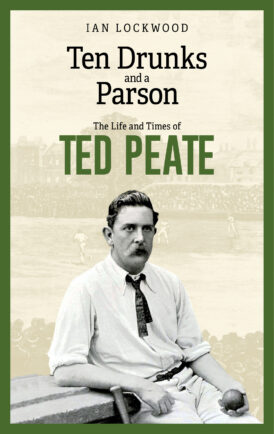Ten Drunks and a Parson
Martin Chandler |Published: 2025
Pages: 222
Author: Lockwood, Ian
Publisher: Pitch
Rating: 3.5 stars

A book with an interesting title which could cover a multitude of subjects, but the sub-title quickly makes it clear what this one is all about, The Life and Times of Ted Peate.
Not everyone will recognise the name so, very briefly, Peate was a Yorkshireman. An orthodox left arm spinner he was the first of the sequence of such bowlers that continued with Bobby Peel, Wilfred Rhodes, Hedley Verity and Johnny Wardle.
As well as those who followed him Peate was also an England player. He took 8-71 in the only Test of 1882 although in, seemingly, not trusting Charles Studd or, perhaps, having started to celebrate early, he got himself out seven runs short of the target set by Australia and a match that might have been a victory remembered as Peate’s Match became the the match that created the legend of ‘The Ashes’.
One unusual, for the times, feature of Peate’s career is that it only lasted for eight seasons. Legend has it that Peate, one of the ten, was so fond of his drink that he was sacked by Lord Hawke as a result. Lockwood doesn’t entirely buy into that one, and his argument if it is not quite a compelling one, certainly makes sense.
Sadly Peate died at just 45, living just long enough to see the first weeks of the twentieth century. His was a varied life, as well as playing for Yorkshire and England playing as a league professional and, in his youth, as a member of a troupe of clown cricketers, a variation on the theme of the game that enjoyed a brief period of popularity in the 1870s.
Author Lockwood came across Peate whilst writing a history of his home town, Skipton, whose cricket club employed Peate for the last years of his life. He seems therefore not to be a hardened cricket tragic, and a couple of errors that should have been picked up at the proof reading stage are testament to that, but the way that he has gone about his task makes it very clear that he is an accomplished historian.
The problem with telling Peate’s life story is he left behind no diaries, scrapbooks or caches of correspondence or memorabilia. Nor, whilst it would appear there are likely descendants around and Lockwood certainly tried to find them, none came forward with anything helpful.
On the other hand this is Yorkshire, and the history of cricket in the county has been well chronicled and Hawke in particular, but others as well, went into print. With a vast number of local newspapers to research as well Lockwood has found plenty of interesting material and has presented it in an attractive and engaging narrative.
Biographies of players from Edmund Peate’s era are, unless the subject is William Gilbert Grace, a rarity and those there are struggle to bring their subjects to life. Peate presented the usual problems for Ian Lockwood but, by dint of thorough research and a way with words he has managed to inject life into the story of a fine cricketer from just before ‘The Golden Age’ and the result is a book, for those with an interest in the era, that is well worth investing in.






Leave a comment